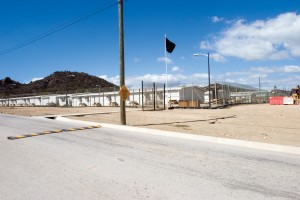Making Sense of Guantánamo
National Dialogue and Traveling Exhibit
Guantánamo.
What does this word call to mind? Until starting the Guantánamo Public Memory Project, my mind conjured up several thoughts upon hearing this word — injustice, torture, the War on Terror — and then went blank, only to be replaced by feelings of confusion and ignorance. I like to think that I’m a well-informed individual, but in the case of Guantánamo, I quickly realized how little I knew.
This troubled me. After having now read more deeply into Guantánamo’s past and present, I wondered what my previous lack of knowledge and lack of interest could stem from.
From the start of this project, I noticed how little we hear about Guantánamo today. I would say that I experienced the height of media coverage and the torture debate surrounding the detention camp while I was in high school, which, as a graduate student, feels far off. Between then and now, so many other events have demanded our nation’s limited attention. There have been natural disasters, uprisings, changes in government, and the economic crisis. Guantánamo seems not to have changed and therefore faded out of memory.
I think some of my confusion about Guantánamo can be linked to its fading from our national consciousness. What is going on there right now? Why can’t it be shut down?
The answers, if there are any definite ones, are frustratingly complex. This layer of complexity now arises when I think about Guantánamo. While researching the legal rights of the current detainees, I encountered the government’s attempts to mold policies, court rulings that grew increasingly strict, laws that seemed designed to spite these rulings, and the government’s indecision due to lack of legal precedent. Despite my lack of fluency in legal jargon, I waded through various primary sources, from court cases to the Geneva Conventions. I would guess that were other average Americans to brave this reading, they too would share my initial confusion over references to previous court cases and the language that allowed the government to create “enemy combatants.” Guantánamo cannot be easily figured out, even amongst policy-makers and legal experts, and this complexity is a lesson in itself. This complexity is bound up with the present-day status of Guantánamo and I believe that it shows that in order to understand Guantánamo, we have to accept a certain level of not understanding.
Even though we might not understand everything that has happened at Guantánamo, we can accept that many injustices took place and are taking place there. But how have so many of us in the United States become immune to this injustice; how has it lost relevancy? Again, I would suppose that a factor might be the lack of serious attention given to Guantánamo in the media. The article “Comfort, irony, and trivialization: The mediation of torture,” by Marita Sturken, proposes that the way that torture is treated in the media, and by our society more generally, can explain this inattention. She writes that images, like the one of the prisoner in Iraqi prison Abu Ghraib, may have lost their power by becoming icons and part of the everyday. Torture has been trivialized by downplaying its awfulness (“hey, work is torture too”) and even creating jokes around it, like on kitschy T-shirts (“Greetings from GITMO Resort and Spa”). We use these methods to distance ourselves from the painful reality, thereby creating our own reality in which we don’t have to deal with the pain. Many Americans have grown to accept the quandary that is Guantánamo. Even if we do feel outraged about torture, amidst the complex veil of Guantánamo, we aren’t sure what we can do about it or why it matters. We may not like its continued existence, but we see no way out and have come to accept it.
Hopefully the more we discuss these issues surrounding Guantánamo, the more relevant and understandable they will become and we can come closer to resolving this era of the base’s history.
Posted by Elena Rippel – MA Candidate at IUPUI
Indiana University – Purdue University of Indianapolis is participating in the Guantánamo Public Memory Project‘s National Dialogue and Traveling Exhibit. Opening at NYU’s Kimmel Center for University Life Windows Gallery in December 2012 and traveling to 9 sites (and counting) across the country through at least 2014, the exhibit will explore GTMO’s history from US occupation in 1898 to today’s debates and visions for its future. The exhibit is being developed through a unique collaboration among a growing number of universities as a dialogue among their students, communities, and people with first-hand experience at GTMO.

